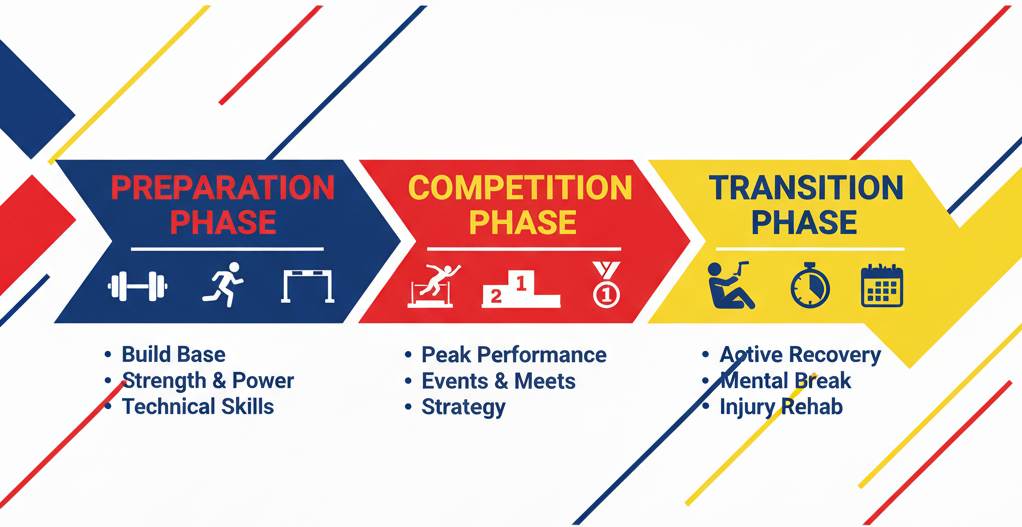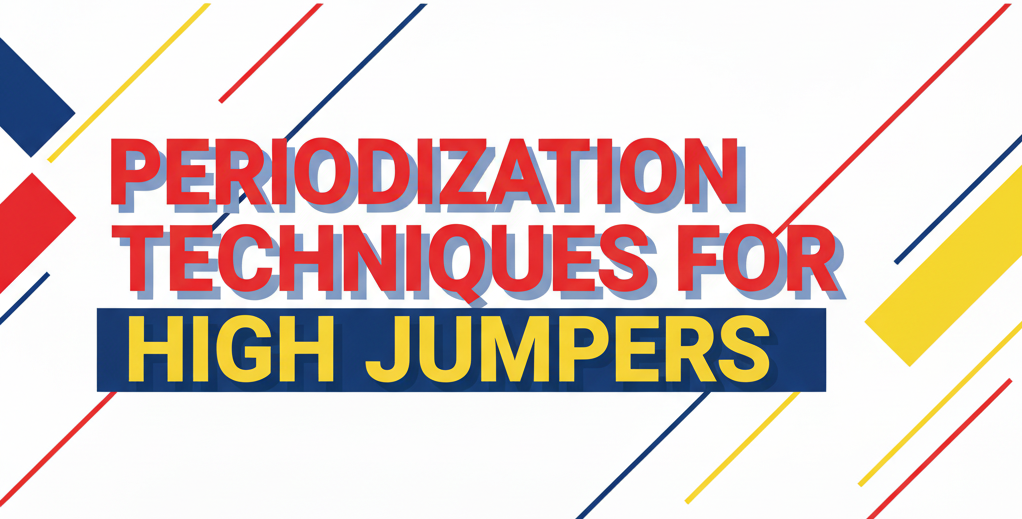Periodization Techniques for High Jumpers: Introduction
In the high-stakes world of competitive high jumping, optimizing training cycles is crucial for peak performance and longevity in the sport. Periodization, the systematic planning of athletic training, plays a vital role in achieving these goals. By strategically organizing training phases, high jumpers can enhance their physical capabilities, refine technique, and prevent burnout. This article delves into advanced periodization techniques tailored for high jump athletes, offering a comprehensive guide to structuring training cycles that maximize performance and maintain athlete well-being.
Every centimeter in high jump matters, and the difference between setting a personal record and falling short often comes down to how effectively an athlete has prepared. Unlike many sports where conditioning alone can drive success, high jumping demands a precise balance of technical skill, explosive power, and mental fortitude. This unique combination requires thoughtful periodization methods for high jump athletes that address all components of performance while preventing overtraining.
Competitive high jumpers face numerous challenges including technical complexity, the psychological pressures of competition, and the risk of injury from repetitive explosive movements. Advanced periodization strategies for competitive high jumpers address these challenges by creating structured yet flexible training plans that evolve with the athlete’s development.
Periodization Techniques for High Jumpers: Macrocycle Planning for Long-Term Development
Macrocycle planning forms the foundation of advanced periodization strategies for competitive high jumpers. A well-designed macrocycle typically spans 6-12 months and provides the overarching structure that guides an athlete’s long-term development.
When designing a macrocycle for high jump training, coaches must begin by identifying key competitions and establishing clear performance goals. These competitions serve as anchors in the training calendar, allowing for backward planning to ensure the athlete reaches peak condition at the right time. For most elite high jumpers, a season might include indoor competitions, outdoor competitions, and potentially championship events, each requiring strategic timing of peak performance.
The traditional macrocycle includes three distinct phases: preparation, competition, and transition. During the preparation phase, high jumpers focus on building a strong foundation of general physical preparedness, including strength development, basic technical work, and cardiovascular conditioning. This phase typically comprises the highest volume of training with moderate intensity. For high jumpers specifically, this phase should include substantial work on developing leg strength, core stability, and basic jumping mechanics.
As the athlete moves into the competition phase, training volume gradually decreases while intensity increases. Technical refinement becomes paramount, with an emphasis on approach run consistency, takeoff mechanics, and bar clearance techniques. Competition-specific drills and simulation training help prepare the athlete for the psychological aspects of performance. The special preparation period within this phase is when high jumpers begin to integrate all components of the jump, working at near-maximal heights and refining their competition strategy.
The transition phase, often overlooked but critically important, allows for physical and mental recovery following the competitive season. For high jumpers, this might include active recovery activities that maintain fitness without the stress of technical jumping work. This period also provides an opportunity to address any weaknesses or imbalances that have become apparent during the competitive season through targeted corrective exercises.
- Define long-term goals based on competition schedules, with specific height targets for different parts of the season.
- Divide the macrocycle into distinct phases: preparation (building strength and basic technique), competition (refining technique and maximizing performance), and transition (recovery and evaluation).

Periodization Techniques for High Jumpers: Mesocycle Adjustments for Specific Training Phases
Within each macrocycle, mesocycles offer a more detailed framework for training, typically lasting 3-6 weeks. For high jumpers, these medium-term cycles allow for targeted focus on specific aspects of performance, creating a progressive training effect that builds toward competition readiness.
During the general preparation phase, mesocycles might focus on developing foundational strength, emphasizing exercises like squats, deadlifts, and Olympic lifting variations that build lower body power. These strength-focused mesocycles are crucial for high jumpers, as they develop the explosive force needed for takeoff. A subsequent mesocycle might then shift toward more plyometric training, including depth jumps, bounding exercises, and medicine ball throws that translate raw strength into sport-specific power.
As the athlete approaches the competition phase, mesocycles should progressively emphasize technical development. One effective approach is to organize these mesocycles around specific technical elements of the high jump. For example, one 4-week block might prioritize approach run consistency, with drills focused on rhythm, acceleration, and curve running technique. The following mesocycle could then focus on takeoff mechanics, including drills that isolate the penultimate step and vertical force application.
For elite high jumpers, specialized mesocycles might address psychological preparation as major competitions approach. These could include visualization training, competition simulation, and pressure testing through artificially created competitive scenarios. This psychological periodization is particularly important in technical events like the high jump, where confidence and mental clarity are crucial for success.
The intensity and volume within mesocycles should follow a wave-like pattern, with 2-3 weeks of progressive loading followed by a recovery week. This undulating approach prevents burnout while allowing for adaptation. For high jumpers, this might mean gradually increasing jump volume or bar height for several weeks, followed by a week of reduced jumping but maintained strength work to allow for neuromuscular recovery.
Tailoring mesocycles to the individual athlete’s needs is essential. Some high jumpers may require additional technical work, while others might benefit from more strength development. Periodization methods for high jump athletes should be flexible enough to accommodate these individual differences while maintaining the overall structure of the training plan.
- Emphasize strength and conditioning during preparatory phases, with focused mesocycles dedicated to developing explosive power needed for takeoff.
- Prioritize technical drills and competition readiness as major events approach, with specialized mesocycles addressing approach, takeoff, and bar clearance.
Periodization Techniques for High Jumpers: Mesocycle Adjustments for Specific Training Phases
Within each macrocycle, mesocycles offer a more detailed framework for training, typically lasting 3-6 weeks. For high jumpers, these medium-term cycles allow for targeted focus on specific aspects of performance, creating a progressive training effect that builds toward competition readiness.
During the general preparation phase, mesocycles might focus on developing foundational strength, emphasizing exercises like squats, deadlifts, and Olympic lifting variations that build lower body power. These strength-focused mesocycles are crucial for high jumpers, as they develop the explosive force needed for takeoff. A subsequent mesocycle might then shift toward more plyometric training, including depth jumps, bounding exercises, and medicine ball throws that translate raw strength into sport-specific power.
As the athlete approaches the competition phase, mesocycles should progressively emphasize technical development. One effective approach is to organize these mesocycles around specific technical elements of the high jump. For example, one 4-week block might prioritize approach run consistency, with drills focused on rhythm, acceleration, and curve running technique. The following mesocycle could then focus on takeoff mechanics, including drills that isolate the penultimate step and vertical force application.
For elite high jumpers, specialized mesocycles might address psychological preparation as major competitions approach. These could include visualization training, competition simulation, and pressure testing through artificially created competitive scenarios. This psychological periodization is particularly important in technical events like the high jump, where confidence and mental clarity are crucial for success.
The intensity and volume within mesocycles should follow a wave-like pattern, with 2-3 weeks of progressive loading followed by a recovery week. This undulating approach prevents burnout while allowing for adaptation. For high jumpers, this might mean gradually increasing jump volume or bar height for several weeks, followed by a week of reduced jumping but maintained strength work to allow for neuromuscular recovery.
Tailoring mesocycles to the individual athlete’s needs is essential. Some high jumpers may require additional technical work, while others might benefit from more strength development. Periodization methods for high jump athletes should be flexible enough to accommodate these individual differences while maintaining the overall structure of the training plan.
- Emphasize strength and conditioning during preparatory phases, with focused mesocycles dedicated to developing explosive power needed for takeoff.
- Prioritize technical drills and competition readiness as major events approach, with specialized mesocycles addressing approach, takeoff, and bar clearance.
Periodization Techniques for High Jumpers: Conclusion
Advanced periodization techniques are essential for high jumpers aiming to maximize their performance and sustain their athletic careers. By meticulously planning macrocycles, tailoring mesocycles, and varying microcycles, athletes can achieve continuous improvement while minimizing the risk of burnout. Integrating strength and conditioning with periodization, along with attentive monitoring and adjustments based on feedback, allows for a dynamic and responsive training approach. Embrace these strategic periodization methods to elevate your high jump performance and maintain a competitive edge in the sport.
The complexities of high jump demand a sophisticated approach to training organization. Unlike volume-based endurance sports or purely strength-focused events, high jumping requires the careful integration of technical skill, explosive power, and psychological readiness. Advanced periodization strategies for competitive high jumpers address this complexity through systematic planning that targets each component at the appropriate time.
Perhaps the most crucial insight for coaches and athletes is that periodization should never be static. The most effective periodization methods for high jump athletes evolve continuously based on competition results, training responses, and emerging research. This flexible yet structured approach represents the art and science of athletic preparation at its best.
As you implement these periodization techniques, remember that the ultimate goal extends beyond immediate performance improvements. Strategic periodization creates sustainable athletic development, allowing high jumpers to achieve their potential while maintaining health and enthusiasm for the sport. In an event where centimeters and milliseconds determine success, the systematic approach of advanced periodization may be the difference between good and great, between potential and achievement.
Coach Otto is a certified track and field coach with over 15 years of experience working with high jumpers at high school, collegiate, and elite levels.

